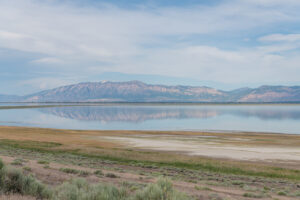June is Pride Month, and here at Utah Clean Energy, we’re thinking about what that means for us. As you may already know, environmental issues don’t affect all communities equally. Some communities (known as frontline communities) will experience the “first and worst” effects of climate change—that is, they are likely to be the first to experience the most severe impacts. Frontline communities often include people of color or those from lower incomes. Part of this risk is geographic; frontline communities often live in areas at higher risk of natural disasters or neighborhoods that don’t have the infrastructure to support emergency services, like emergency shelters. It may not seem intuitive that LGBTQ+ communities are at greater risk of experiencing disproportionate impacts of climate-related disasters, especially because this topic is under-researched, but there are lots of risk factors that make LGBTQ+ communities more vulnerable to climate impacts.
Employment discrimination is a major risk factor for LGBTQ+ communities, especially trans communities. The unemployment rate for LGBTQ+ individuals is nearly double that of cisgender, heterosexual individuals, and it’s even higher for trans individuals—nearly three times that of cisgender, heterosexual individuals. Unemployment or underemployment can lead to poverty, housing insecurity, lack of health insurance, and more difficulties that make dealing with the impacts of climate change that much more challenging.
Lack of health insurance significantly limits access to health care, and LGBTQ+ communities face even more disadvantages in this space. LGBTQ+ patients are likely to avoid seeking care because of the fear of discrimination from their doctors–in fact, 18% of LGBTQ+ adults and 22% of transgender adults reported avoiding health care because they anticipated discrimination. This issue has been in the news a lot in Utah over this past year; in January, the legislature passed SB16, which banned doctors from providing gender-affirming care to their pediatric patients. Even though SB16 included a grandfather clause that allowed the continuation of care for trans children who were already receiving gender-affirming care, some doctors stopped treating their previous patients out of fear of litigation, leaving patients without the care that they need. This kind of discrimination (as well as other forms of discrimination such as harassment or microaggressions) make it more difficult for LGBTQ+ patients to receive and seek medical care. This is especially dangerous as climate change creates heat waves, flooding, and superstorms that increase the risk of illness and injury.
Finally, discriminatory housing policies continue to significantly impact LGBTQ+ communities. Historically, LGBTQ+ communities faced a lot of bias when searching for housing, and unfortunately, this continues today. 19 states do not prohibit housing discrimination based on sexual orientation or gender identity, meaning that LGBTQ+ individuals and families can be denied housing or unfairly evicted. This contributes to high rates of homelessness; 17% of LGBTQ+ individuals have experienced homelessness at some point in their lives, compared to 6% of cisgender, heterosexual individuals. Homelessness is a huge risk factor when it comes to climate change—lack of shelter makes climate disasters, such as severe storms, flooding, heat waves, and more that much more difficult to navigate.
So, what do these factors mean in terms of climate change? When it comes to climate disasters, LGBTQ+ communities often aren’t included in disaster relief. This was a huge problem during Hurricane Katrina; LGBTQ+ people were denied health care (especially if they were HIV positive), and trans people in need of shelter were denied aid from faith-based organizations. In one instance, two Black trans women were arrested for using the bathroom that matched their gender at an emergency shelter. Today, emergency shelters still are not prohibited from discriminating against LGBTQ+ individuals and families, leaving these communities at a high risk of being harmed by climate disasters. Discriminatory housing policies have also caused LGBTQ+ communities to live in areas with high rates of air pollution; residential areas with high proportions of same-sex couples had a 9.8% to 13.3% higher risk of respiratory illnesses.
LGBTQ+ communities have experienced and continue to experience discrimination that leaves them much more vulnerable to environmental exposures, especially climate disasters and air pollution. By leading the clean energy transformation, Utah Clean Energy is working to mitigate climate change and create a safer world for all our communities. You can also make a difference by supporting organizations that are fighting for LGBTQ+ climate justice. OUT for Sustainability works to “co-create climate resilience and environmental justice by and for LGBTQIA+ communities,” and their new initiative Qready is creating accessible disaster relief resources. Learn about more LGBTQ+ climate organizations that are leading the way to create a more equitable future.






